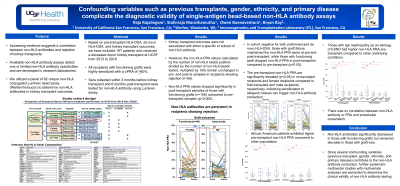Back

(P321) Confounding variables such as previous transplants, gender, ethnicity, and primary disease complicate the diagnostic validity of single-antigen bead-based non-HLA antibody assays.
Location: Platinum Ballroom

Poster Presenter(s)
Aim: Growing evidence indicates a correlation between non-HLA antibodies (nHLA-Ab) and kidney transplant (KTx) rejection. Current nHLA-Ab assays typically detect one or few nHLA-Ab specificities. Herein, we employed a panel of 82 unique nHLA-conjugated Luminex assays (Immucor) to assess nHLA-Ab in KTx outcomes.
Method: Based on preformed DSA (pfDSA), de novo DSA (dnDSA), and KTx outcomes, we included 167 highly sensitized patients with a CPRA >80% who received a deceased donor KTx at UCSF from 2013 to 2018. Sera collected 3 mo pre-Tx and at the diagnosis of Ab-mediated rejection or >1 yr post-Tx from recipients with well-functioning grafts were tested for nHLA-Ab using Luminex assay.
Results: The KTx outcomes were not associated with any specific nHLA-Ab or subset. The nHLA-PRA values, calculated by dividing the number of positive nHLA beads by the total number tested and multiplying by 100, remained consistent in pre- and post-Tx samples among recipients experiencing rejection (n=59). However, nHLA-PRA values significantly decreased in post-Tx samples for recipients with functioning grafts (n=108) compared to pre-Tx samples (P <0.002) (Fig). Specifically, in recipients negative for both pfDSA and dnDSA, those with graft failure maintained consistent nHLA-PRA levels before and after Tx, while those with functioning grafts showed a decrease in nHLA-PRA post-Tx compared to pre-Tx (P <0.05).
Pre-Tx nHLA-PRA levels were significantly higher (P <0.05) in recipients undergoing re-Tx and in females compared to those receiving their first Tx and males, respectively, indicating that prior exposure to allogeneic tissues may trigger nHLA-Ab production. Additionally, Africans shown higher pre-Tx nHLA-PRA compared to other racial groups, and patients with IgA nephropathy had higher pre-Tx nHLA-PRA compared to those with other underlying conditions. No correlation was observed between nHLA-Ab or nHLA-PRA and endothelial cell crossmatching.
Conclusion: Compared to pre-Tx levels, nHLA-PRA decreased significantly in post-Tx samples for individuals with functioning grafts, but it remained elevated for those who experienced graft loss. Because several confounding factors influence nHLA-Ab production, further systematic studies with more participants and multivariate analyses are needed to establish the clinical validity of nHLA-Ab testing.
Method: Based on preformed DSA (pfDSA), de novo DSA (dnDSA), and KTx outcomes, we included 167 highly sensitized patients with a CPRA >80% who received a deceased donor KTx at UCSF from 2013 to 2018. Sera collected 3 mo pre-Tx and at the diagnosis of Ab-mediated rejection or >1 yr post-Tx from recipients with well-functioning grafts were tested for nHLA-Ab using Luminex assay.
Results: The KTx outcomes were not associated with any specific nHLA-Ab or subset. The nHLA-PRA values, calculated by dividing the number of positive nHLA beads by the total number tested and multiplying by 100, remained consistent in pre- and post-Tx samples among recipients experiencing rejection (n=59). However, nHLA-PRA values significantly decreased in post-Tx samples for recipients with functioning grafts (n=108) compared to pre-Tx samples (P <0.002) (Fig). Specifically, in recipients negative for both pfDSA and dnDSA, those with graft failure maintained consistent nHLA-PRA levels before and after Tx, while those with functioning grafts showed a decrease in nHLA-PRA post-Tx compared to pre-Tx (P <0.05).
Pre-Tx nHLA-PRA levels were significantly higher (P <0.05) in recipients undergoing re-Tx and in females compared to those receiving their first Tx and males, respectively, indicating that prior exposure to allogeneic tissues may trigger nHLA-Ab production. Additionally, Africans shown higher pre-Tx nHLA-PRA compared to other racial groups, and patients with IgA nephropathy had higher pre-Tx nHLA-PRA compared to those with other underlying conditions. No correlation was observed between nHLA-Ab or nHLA-PRA and endothelial cell crossmatching.
Conclusion: Compared to pre-Tx levels, nHLA-PRA decreased significantly in post-Tx samples for individuals with functioning grafts, but it remained elevated for those who experienced graft loss. Because several confounding factors influence nHLA-Ab production, further systematic studies with more participants and multivariate analyses are needed to establish the clinical validity of nHLA-Ab testing.

